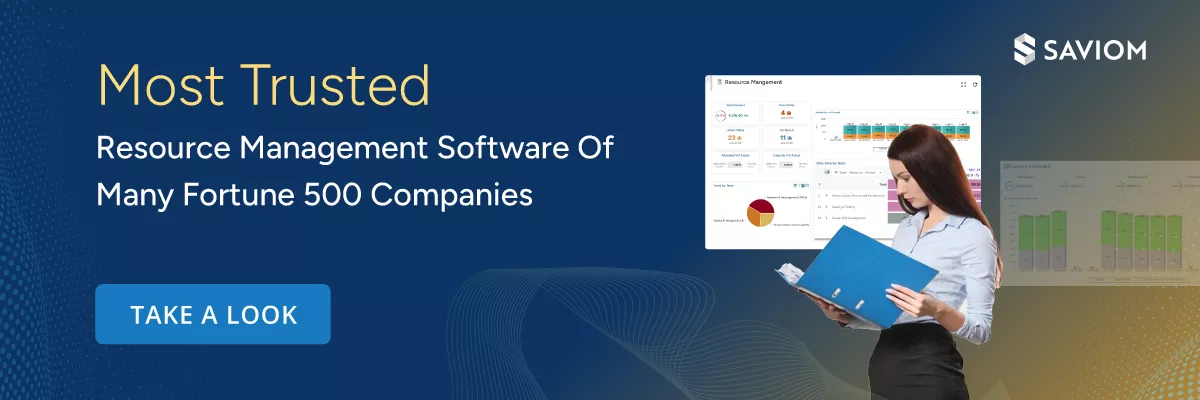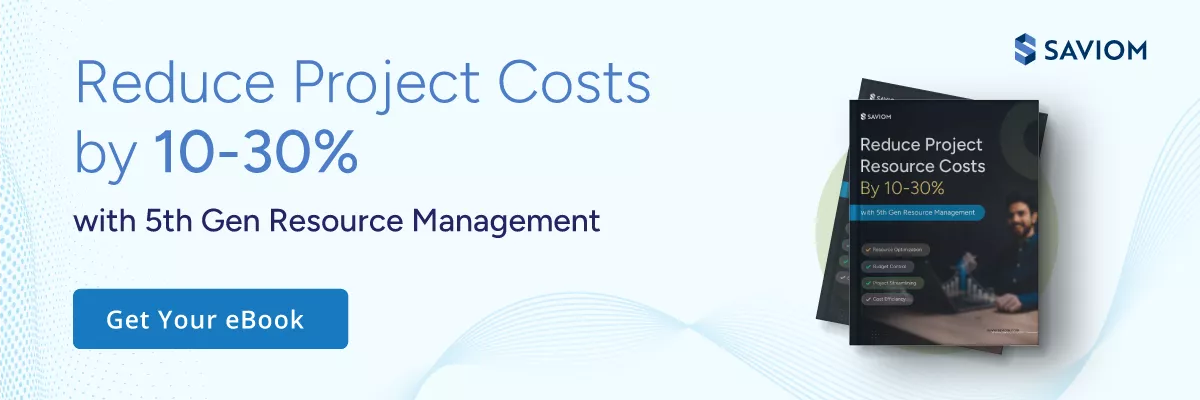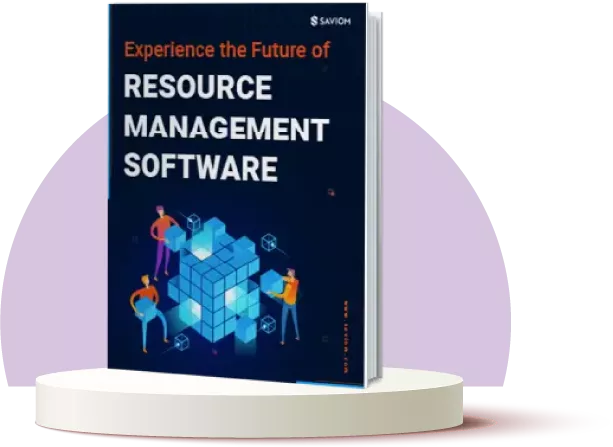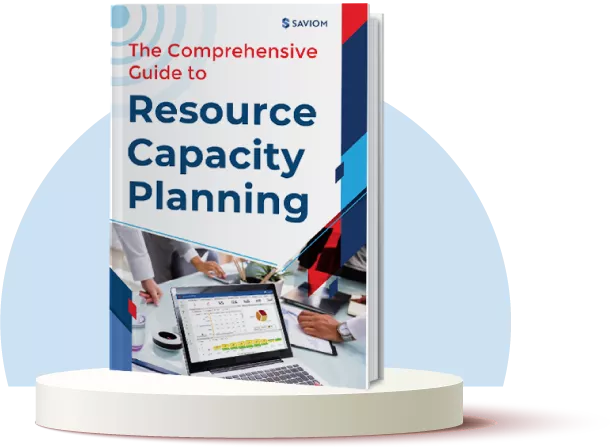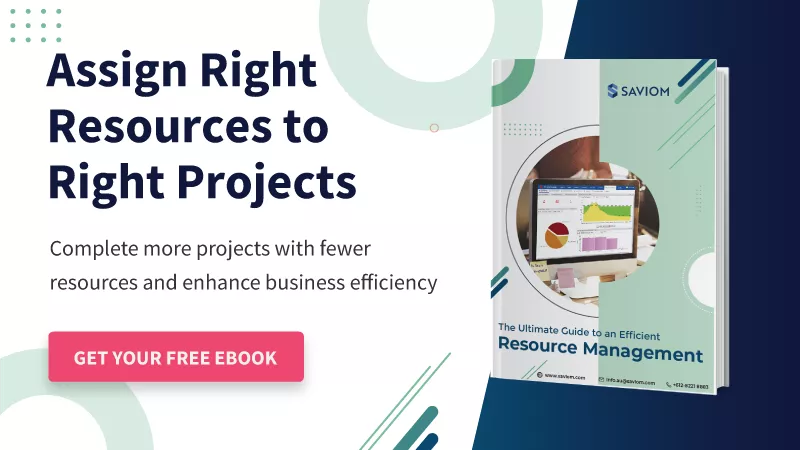Introduction
Every organization depends on people, tools, and technology to function smoothly. But simply having the necessary resources isn’t enough. It’s how they are managed and optimized that makes the real difference. Without a structured framework, resources are either stretched too thin, underutilized, or assigned to tasks that don’t align with their capabilities.
Consequently, the organization suffers from poor workforce performance, project delays, dissatisfied clients, and ultimately, missed market opportunities. That’s why resource management is important for any business seeking to grow sustainably.
Resource management ensures that the right number of people with the optimal skills are available to meet the current and future project demands. It further enables managers to optimize the utilization of available team members and prevent instances of under-allocation or overloading. When done well, it helps organizations reduce costs, boost productivity, and achieve their long-term business goals.
In this blog, we will break down 15 reasons why resource management is important and why it should be at the heart of every successful business strategy.
Let’s explore.
Why is Resource Management Important?
Effective resource management is essential for delivering projects on time, within budget, and at the expected quality. Listed below are key benefits of resource management:
Optimal Resource Utilization
Effective resource management plays a fundamental role in maximizing billable, strategic, and high-value utilization across the organization. It begins with resource forecasting and capacity planning, which helps ensure the right skills and competencies are readily available for critical, high-value projects. This facilitates competent resource allocation and boosts employee productivity.
Next, real-time visibility into resource utilization levels enables managers to identify and address under- and over-allocation. This ensures that everyone is utilized optimally within their capacity and minimizes instances of burnout, disengagement, or extended bench time. Moreover, they can proactively mobilize resources from non-billable work to billable projects, maximizing productive utilization.
Dive deeper: What is Resource Utilization? How to Measure and Optimize Efficiently?
Faster Project Delivery
Faster project delivery depends on having the right type, quantity, and quality of resources available at the right time. Through multi-dimensional forecasting, managers can analyze resource demands for pipeline projects and secure the necessary skills ahead of time.
This forward planning helps create realistic project schedules, prevents last-minute skill shortages, maintains resource quality, and ensures timely initiation. On top of that, well-defined resource management practices enable managers to quickly reallocate staff in response to challenges such as scope changes, unplanned absenteeism, sudden attrition, etc. Therefore, it allows firms to deliver projects faster and efficiently.
Balanced Supply and Demand
With the help of resource capacity planning, organizations can proactively forecast, analyze, and bridge the supply vs. demand gap to ensure they are equipped with a competent workforce at all times. It helps address resource excess and deficit with corrective action such as upskilling/retraining, hiring, or out-rotation and backfill strategy.
Aligning resource capacity with demand eliminates last-minute firefighting and facilitates timely project initiation. Moreover, it enables businesses to build a mix of permanent/ contingent, part-time/full-time, and local/global workforce to meet demand volatilities. Thus, balanced supply and demand helps firms to future-proof the workforce and safeguard business profitability.
New to capacity planning? Learn how to balance your resources with project demand with these blogs.
- What is a Capacity Model? A Guide to Improve Business Efficiency
- What is a Capacity Report: Definition, Benefits & Steps to Build One
- Top Capacity Planning Challenges & 9 Ways to Overcome Them
Reduced Resourcing Wastage
Effective resource management significantly reduces resourcing wastage by ensuring every employee is optimally allocated, utilized, and managed across all projects and business functions. It minimizes wasteful hiring/firing cycles and prolonged bench time by enabling accurate and proactive demand forecasting across multiple dimensions such as skill, role, location, cost, etc.
Concurrently, it minimizes last-minute firefighting, work duplication, and skill mismatches, which often lead to wasted time, budget, and effort. Furthermore, resource management tracks actual performance against forecasted values over a specified time period. This, in turn, helps make smarter resourcing decisions for future projects and minimize capacity wastage.
Delivery within Project Budget
According to a Harvard Business Review, “A study of 5,400 IT projects found average cost overruns of 27%, with about 1 in 6 projects going over budget by 200%.”
Budget overruns are a common phenomenon across all industries; however, effective resource management can help prevent this. It ensures every project is equipped with the right mix of resources. Depending on the project’s nature, managers can leverage a cost-effective blend of permanent, contingent, local, and global resources to reduce expenditure without compromising on quality.
Besides, managers can monitor and optimize productive utilization of project resources to prevent schedule delays, which ultimately helps curb cost escalations. On the other hand, resource management enables firms to create accurate project budgets based on employees’ actual cost rates and charge-out rates. Collectively, these practices help ensure project delivery within the pre-defined budget.
Explore further: How to Develop an Effective Project Budget in 8 Simple Steps?
Improved Strategic Alignment
A well-structured resource management process plays a crucial role in aligning projects with the organization’s strategic objectives. It enables managers to evaluate and prioritize initiatives based on business value and ROI. Once priorities are set, they can estimate resource requirements and look into internal and external channels to identify and assign suitable candidates to these projects.
This structured approach ensures high-priority projects are executed efficiently within the stipulated timeline, cost, and quality standards. Moreover, by keeping resources focused on value-driven work, organizations enhance short-term project outcomes and achieve long-term business goals.
Increased Employee Productivity
Employee productivity is one of the strongest drivers of project success and business growth. To achieve this, firms must ensure that employees’ time, skills, and efforts are used effectively. Resource management makes this possible by aligning work with employee skills and competencies. When the right people work on the right tasks, they tend to be more productive and less likely to make mistakes.
It eliminates common challenges, such as overallocation, underutilization, extended bench time, and skill mismatches that often lead to delays, rework, disengagement, or wasted effort. Additionally, managers can monitor resource schedules and mobilize employees from low-priority, non-billable work to revenue-generation initiatives, enhancing overall productivity.
Keep reading: 10 Effective Ways to Increase Employee Productivity in the Workplace
Enhanced Operational Efficiency
According to IBM survey, “77% of CEOs view operational efficiency as a key driver of revenue growth, highlighting its strategic importance across industries.”
A robust resource management model directly supports this goal by standardizing and optimizing various resource-centric workflows across the organization. It prevents project and operational delays by ensuring businesses are always equipped with the right talent at the right time and cost.
Furthermore, resource management helps establish strong communication and collaboration protocols, which streamlines business workflows and enable effective resource sharing across matrix boundaries. Besides, continuous time tracking and KPI monitoring enable managers to identify and rectify variances. This way, robust resource management practices foster enhanced operational efficiency.
Targeted Upskilling & Reskilling
According to a World Economic Forum report, “Between 2025 and 2030, about 39% of the skills employees currently use will either change significantly or become obsolete.”
A multitude of factors, such as rapid technological advancements, demographic shifts, changing employee preferences, and intense talent competition, have created an acute skill gap and shortage globally. Consequently, organizations must maximize the potential of their existing workforce by implementing targeted upskilling and reskilling initiatives. Instead of generic training programs, a targeted approach focuses on skills directly tied to project requirements, emerging technologies, organizational goals, or specific future roles.
These programs help equip employees with versatile, transferable competencies that allow them to expand their roles and responsibilities within the organization. Moreover, it ensures training investments directly impact business outcomes. Therefore, targeted learning and development opportunities can help build critical capabilities internally, reduce dependency on external hiring, and future-proof the workforce.
Dive deeper: How Can Retraining/Upskilling Future-Proof Your Workforce?
 SAVIOM’s Competency Matrix maps, updates, and tracks resource skills, qualifications, competencies, and helps identify potential candidates for targeted upskilling and reskilling.
SAVIOM’s Competency Matrix maps, updates, and tracks resource skills, qualifications, competencies, and helps identify potential candidates for targeted upskilling and reskilling.
Data-Driven Decision Making
Resource management creates the foundation for data-driven decision-making by transforming siloed and fragmented resource workflows into centralized and well-organized processes. It provides comprehensive insights into resource attributes such as availability, utilization, capacity, cost, skills, and location, allowing organizations to plan and optimize their workforce dynamically to meet current and future business needs.
Instead of relying on guesswork and approximation, firms leverage real-time data to make critical hiring, training, and allocation decisions. It helps business leaders to respond promptly to changing market conditions and make the most of their existing talent pool. Over time, this operational data evolves into strategic intelligence that helps shape long-term resource planning and business growth strategies.
Lowered Project Risk
Resource management consolidates all resource-centric data into a unified platform. Such comprehensive visibility allows decision-makers to easily identify workforce risks such as resource unavailability, skill gaps, mismatched allocations, sub-optimal utilization, employee burnout, high attrition rates, etc. Accordingly, managers can implement course-correction measures to mitigate resource risks, and maintain project momentum.
Moreover, they can leverage scenario modelling and simulation to create an optimal resource plan within the existing constraints and safeguard project profitability. Thus, proactive resource planning can help organizations circumvent resourcing bottlenecks and minimize project risks such as schedule delays, budget overruns, and poor deliverable quality.
Want to know more? Continue reading: Top 12 IT Project Risks: Effective Ways to Mitigate Them
Streamlined Resource Requisition Workflow
With an efficient resource management solution, businesses can standardize and streamline the resource requisition workflow. Rather than relying on siloed spreadsheets, all resource requests are raised, reviewed, and fulfilled through a centralized system with predefined templates that capture essential details such as required skills, roles, expertise level, timelines, and cost rates.
A standardized requisition workflow ensures timely resource allocations, prevents project delays, and maintains an audit trail. This promotes a culture of transparency and accountability. Moreover, it eliminates favoritism, minimizes managerial conflicts, and ensures that resourcing decisions are based on project needs, priorities, and individual expertise.
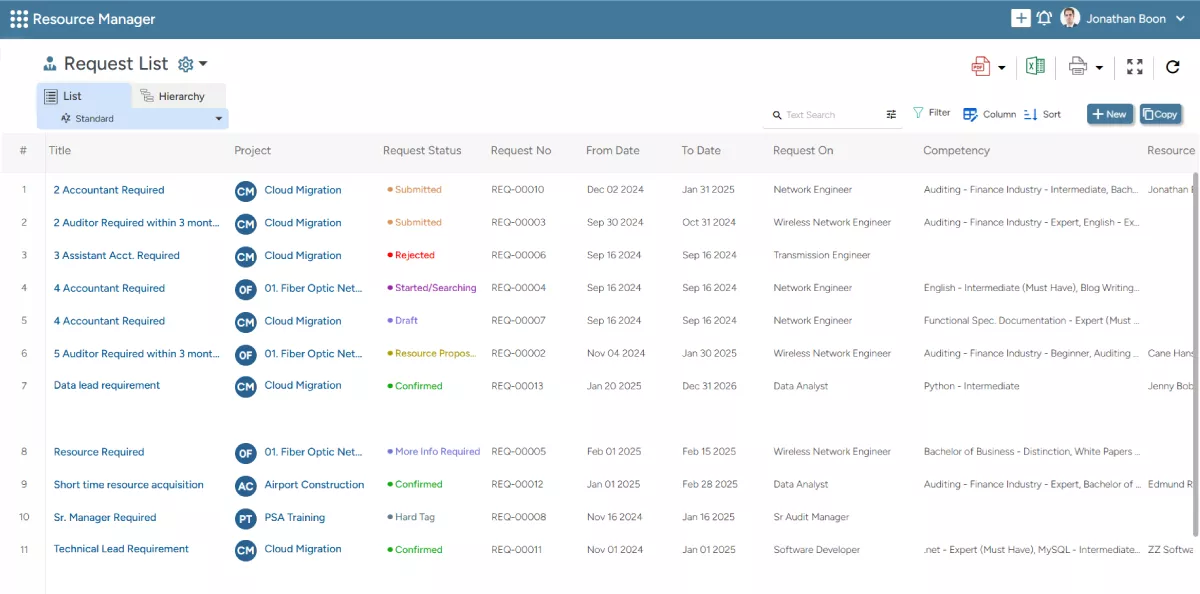 SAVIOM’s Automated Resource Requisition Workflow allows managers to raise resource requests and ensure timely allocations.
SAVIOM’s Automated Resource Requisition Workflow allows managers to raise resource requests and ensure timely allocations.
High Employee Morale
Effective resource management helps align project tasks with resource skills and expertise. This keeps resources engaged and productive, resulting in higher employee morale and job satisfaction. Moreover, it promotes equal workload distribution, preventing instances of burnout and disengagement.
A well-structured resource management framework allows employees to express interest in upcoming projects, giving them greater ownership and a hands-on learning experience. Together, these practices cultivate a supportive work environment where employees feel motivated to contribute to the organization’s success.
Read further: Signs of Low Employee Morale and How to Course Correct
Better Customer Satisfaction
As discussed earlier, resource management plays a fundamental role in ensuring successful project delivery. Firstly, it helps facilitate skill-based resource allocation to ensure high productivity, minimize expensive rework, and maintain deliverable quality. As a result, clients experience fewer delays, better outcomes, and confidence that their project is in capable hands. Secondly, it prevents last-minute and wrongful hiring, preventing cost escalations.
This enhances the perceived value of deliverables and reduces billing disputes among clients. Lastly, effective resource management fosters communication and transparency, which enhances customer confidence and reduces uncertainty. Cumulatively, these factors enable firms to deliver projects within the stipulated time, budget, and quality. Over time, consistent delivery of successful projects leads to loyalty and repeat business as clients trust the organization as a reliable partner for future needs.
Faster Response to Market Conditions
To stay competitive in the business landscape, organizations must be agile and responsive to changing market dynamics. Here, effective resource management empowers firms to gain foresight into workforce attributes and make data-driven business decisions. It also helps them stay forewarned of future skill requirements, providing them with sufficient lead time to identify resource gaps and take corrective action to build a robust talent pipeline.
Creating a future-ready workforce enables companies to take on advanced, high-value client projects. Beyond that, agile capacity planning allows firms to align internal capacity with dynamically changing market demand. This helps minimize the likelihood of resource constraints and operational delays. Ultimately, it enables organizations to adapt resource allocations in real-time and capture emerging business opportunities.
Now that we have explored the importance of resource management, let’s look at how SAVIOM supports it in practice.
How Does SAVIOM Enable These Benefits?
Here is how SAVIOM helps organizations reap the benefits of effective resource management and stay ahead in a competitive business environment.
Most Advanced and Powerful Solution
In today’s volatile market, where economic shifts and fierce competition dominate, businesses are under constant pressure to deliver more with fewer resources. Hence, to remain profitable and sustainable, organizations need to maximize the potential of their resources. SAVIOM’s next-gen resource management software helps meet this challenge by enabling firms to foresee future project demands, allocate resources effectively, boost employee productivity, and accelerate business growth.
Highly Configurable and Adaptable Solution
Every business operates with its own processes, approval flows, and reporting structures, making rigid, one-size-fits-all systems ineffective in the long run. Therefore, organizations need an adaptable resource management solution that caters to their specific ways of working. SAVIOM offers exceptional flexibility, enabling organizations to configure the platform according to their unique business requirements while maintaining productivity. It also scales effortlessly to manage growing workloads and expanding data, ensuring sustained performance and stronger profitability as the business evolves.
5th Gen Resource Management Maturity
SAVIOM’s 5th generation resource management solution is designed to meet the complex and ever-changing demands of modern enterprises. Created with a future-focused approach, it helps organizations utilize their resources in the most effective way to achieve successful project outcomes. SAVIOM offers advanced features, including multi-dimensional forecasting, dynamic capacity planning, real-time allocation, continuous optimization, and scenario modeling. With these capabilities, businesses can enhance utilization, advance their resource management maturity, and strengthen their competitive advantage.
Pioneer and Market Leader of Resource Management
SAVIOM has established itself as a trusted name in enterprise resource management, with clients that include Fortune 500 companies and leading organizations such as Verizon, ABB, Fujitsu, Siemens, Grant Thornton, and Alix Partners. Its solutions are implemented across multiple industries in more than 50 countries, helping enterprises maximize utilization, improve project delivery, and meet strategic goals. With over two decades of expertise, SAVIOM continues to set benchmarks in resource management and drive innovation for the future.
Conclusion
Resource management plays a central role in helping organizations use their personnel and assets efficiently. It not only reduces resourcing costs and project risks but also improves productivity, customer satisfaction, and business agility. Ultimately, by aligning resources with strategic priorities and preparing for future demands, firms can build resilience and stay competitive in a changing market.
